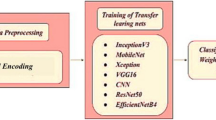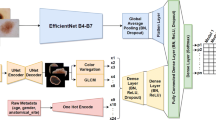Abstract
Melanoma is the most lethal of all skin cancers. This necessitates the need for a machine learning-driven skin cancer detection system to help medical professionals with early detection. We propose an integrated multi-modal ensemble framework that combines deep convolution neural representations with extracted lesion characteristics and patient meta-data. This study intends to integrate transfer-learned image features, global and local textural information, and patient data using a custom generator to diagnose skin cancer accurately. The architecture combines multiple models in a weighted ensemble strategy, which was trained and validated on specific and distinct datasets, namely, HAM10000, BCN20000 + MSK, and the ISIC2020 challenge datasets. They were evaluated on the mean values of precision, recall or sensitivity, specificity, and balanced accuracy metrics. Sensitivity and specificity play a major role in diagnostics. The model achieved sensitivities of 94.15%, 86.69%, and 86.48% and specificity of 99.24%, 97.73%, and 98.51% for each dataset, respectively. Additionally, the accuracy on the malignant classes of the three datasets was 94%, 87.33%, and 89%, which is significantly higher than the physician recognition rate. The results demonstrate that our weighted voting integrated ensemble strategy outperforms existing models and could serve as an initial diagnostic tool for skin cancer.






Similar content being viewed by others
Availability of Data and Materials
The datasets are downloaded from the ISIC repository https://challenge.isic-archive.com/data/.
Code Availability
References
De Giorgi, V., Papi, F., Giorgi, L., Savarese, I., Verdelli, A.: Skin self-examination and the abcde rule in the early diagnosis of melanoma: is the game over? British Journal of Dermatology (1951) 168(6), 1370–1371 (2013)
Henning, J.S., Dusza, S.W., Wang, S.Q., Marghoob, A.A., Rabinovitz, H.S., Polsky, D., Kopf, A.W.: The cash (color, architecture, symmetry, and homogeneity) algorithm for dermoscopy. Journal of the American Academy of Dermatology 56(1), 45–52 (2007)
Argenziano, G., Fabbrocini, G., Carli, P., De Giorgi, V., Sammarco, E., Delfino, M.: Epiluminescence microscopy for the diagnosis of doubtful melanocytic skin lesions: comparison of the abcd rule of dermatoscopy and a new 7-point checklist based on pattern analysis. Archives of Dermatology 134(12), 1563–1570 (1998)
Monika, M.K., Vignesh, N.A., Kumari, C.U., Kumar, M., Lydia, E.L.: Skin cancer detection and classification using machine learning. Materials Today: Proceedings 33, 4266–4270 (2020)
Zghal, N.S., Derbel, N.: Melanoma skin cancer detection based on image processing. Current Medical Imaging 16(1), 50–58 (2020)
Ghalejoogh, G.S., Kordy, H.M., Ebrahimi, F.: A hierarchical structure based on stacking approach for skin lesion classification. Expert Systems with Applications 145, 113127 (2020)
Hameed, N., Shabut, A.M., Ghosh, M.K., Hossain, M.A.: Multi-class multi-level classification algorithm for skin lesions classification using machine learning techniques. Expert Systems with Applications 141, 112961 (2020)
Kassem, M.A., Hosny, K.M., Fouad, M.M.: Skin lesions classification into eight classes for isic 2019 using deep convolutional neural network and transfer learning. IEEE Access 8, 114822–114832 (2020)
Yilmaz, A., Gencoglan, G., Varol, R., Demircali, A.A., Keshavarz, M., Uvet, H.: Mobileskin: Classification of skin lesion images acquired using mobile phone-attached hand-held dermoscopes. Journal of Clinical Medicine 11(17), 5102 (2022)
Nahata, H., Singh, S.P.: Deep learning solutions for skin cancer detection and diagnosis. Machine Learning with Health Care Perspective, 159–182 (2020)
Gessert, N., Sentker, T., Madesta, F., Schmitz, R., Kniep, H., Baltruschat, I., Werner, R., Schlaefer, A.: Skin lesion diagnosis using ensembles, unscaled multi-crop evaluation and loss weighting. arXiv preprint arXiv:1808.01694 (2018)
Xin, C., Liu, Z., Zhao, K., Miao, L., Ma, Y., Zhu, X., Zhou, Q., Wang, S., Li, L., Yang, F., et al.: An improved transformer network for skin cancer classification. Computers in Biology and Medicine 149, 105939 (2022)
Gessert, N., Nielsen, M., Shaikh, M., Werner, R., Schlaefer, A.: Skin lesion classification using ensembles of multi-resolution efficientnets with meta data. MethodsX 7, 100864 (2020)
Benyahia, S., Meftah, B., L´ezoray, O.: Multi-features extraction based on deep learning for skin lesion classification. Tissue and Cell 74, 101701 (2022)
Ha, Q., Liu, B., Liu, F.: Identifying melanoma images using efficient net ensemble: Winning solution to the siimisic melanoma classification challenge. arXiv preprint arXiv:2010.05351 (2020)
Qureshi, A.S., Roos, T.: Transfer learning with ensembles of deep neural networks for skin cancer detection in imbalanced data sets. Neural Processing Letters, 1–19 (2022)
Adepu, A.K., Sahayam, S., Jayaraman, U., Arramraju, R.: Melanoma classification from dermatoscopy images using knowledge distillation for highly imbalanced data. Computers in Biology and Medicine 154, 106571 (2023)
Teodoro, A.A., Silva, D.H., Rosa, R.L., Saadi, M., Wuttisittikulkij, L., Mumtaz, R.A., Rodriguez, D.Z.: A skin cancer classification approach using gan and roi-based attention mechanism. Journal of Signal Processing Systems, 1–14 (2022)
Kumar, K.S., Suganthi, N., Muppidi, S., Kumar, B.S.: Fspbodqn: Segan based segmentation and fractional student psychology optimization enabled deep q network for skin cancer detection in iot applications. Artificial Intelligence in Medicine 129, 102299 (2022)
Tschandl, P., Rosendahl, C., Kittler, H.: The ham10000 dataset, a large collection of multi-source dermatoscopic images of common pigmented skin lesions. Scientific data 5(1), 1–9 (2018)
Combalia, Marc, Noel CF Codella, Veronica Rotemberg, Brian Helba, Veronica Vilaplana, Ofer Reiter, Cristina Carrera et al. "Bcn20000: Dermoscopic lesions in the wild." arXiv preprint arXiv:1908.02288 (2019)
Codella, N.C., Gutman, D., Celebi, M.E., Helba, B., Marchetti, M.A., Dusza, S.W., Kalloo, A., Liopyris, K., Mishra, N., Kittler, H., et al.: Skin lesion analysis toward melanoma detection: A challenge at the 2017 international symposium on biomedical imaging (isbi), hosted by the international skin imaging collaboration (isic). In: 2018 IEEE 15th International Symposium on Biomedical Imaging (ISBI 2018), pp. 168–172 (2018). IEEE
Rotemberg, V., Kurtansky, N., BetzStablein, B., Caffery, L., Chousakos, E., Codella, N., Combalia, M., Dusza, S., Guitera, P., Gutman, D., et al.: A patient-centric dataset of images and metadata for identifying melanomas using clinical context. Scientific data 8(1), 34 (2021)
Koonce, B., Koonce, B.: Efficientnet. Convolutional Neural Networks with Swift for Tensorflow: Image Recognition and Dataset Categorization, 109– 123 (2021)
Lee, T., Ng, V., Gallagher, R., Coldman, A., McLean, D.: Dullrazor®: A software approach to hair removal from images. Computers in biology and medicine 27(6), 533–543 (1997)
Ronneberger, O., Fischer, P., Brox, T.: U-net: Convolutional networks for biomedical image segmentation. In: Medical Image Computing and Computer-Assisted Intervention–MICCAI 2015: 18th International Conference, Munich, Germany, October 5–9, 2015, Proceedings, Part III 18, pp. 234–241 (2015). Springer
Haralick, R.M., Shanmugam, K., Dinstein, I.H.: Textural features for image classification. IEEE Transactions on systems, man, and cybernetics (6), 610–621 (1973)
Ahonen, T., Hadid, A., Pietikainen, M.: Face description with local binary patterns: Application to face recognition. IEEE transactions on pattern analysis and machine intelligence 28(12), 2037–2041 (2006)
Kang, H.: The prevention and handling of the missing data. Korean journal of anesthesiology 64(5), 402–406 (2013)
Shahin, A.H., Kamal, A., Elattar, M.A.: Deep ensemble learning for skin lesion classification from dermoscopic images. In: 2018 9th Cairo International Biomedical Engineering Conference (CIBEC), pp. 150–153 (2018). IEEE
Almaraz-Damian, J.A., Ponomaryov, V., Sadovnychiy, S., Castillejos-Fernandez, H.: Melanoma and nevus skin lesion classification using handcraft and deep learning feature fusion via mutual information measures. Entropy 22(4), 484 (2020)
Guissous, A.E.: Skin lesion classification using deep neural network. arXiv preprint arXiv:1911.07817 (2019)
Acknowledgements
The authors would like to extend gratitude to all researchers and doctors affiliated with the Machine Intelligence Research (MIR) Laboratory for their support during each phase of this work. The authors also thank University of Kerala for providing the infrastructure required for the study.
Funding
This work was supported by University Grants Commission, India with NTA Ref. No.: 200510450932.
Author information
Authors and Affiliations
Contributions
All authors contributed to the study conception and design. Material preparation, data collection, and analysis were performed by Misaj Sharafudeen. The first draft of the manuscript was written by Misaj Sharafudeen. Vinod Chandra SS reviewed and commented on previous versions of the manuscript. All authors read and approved the final manuscript.
Corresponding author
Ethics declarations
Ethics Approval
This article does not contain any studies with human participants or animals performed by the author.
Consent to Participate
Not applicable.
Consent for Publication
Not applicable.
Competing Interests
The authors declare no competing interests.
Additional information
Publisher's Note
Springer Nature remains neutral with regard to jurisdictional claims in published maps and institutional affiliations.
Supplementary Information
Below is the link to the electronic supplementary material.
Rights and permissions
Springer Nature or its licensor (e.g. a society or other partner) holds exclusive rights to this article under a publishing agreement with the author(s) or other rightsholder(s); author self-archiving of the accepted manuscript version of this article is solely governed by the terms of such publishing agreement and applicable law.
About this article
Cite this article
Sharafudeen, M., S S, V.C. An Integrated Ensemble Network Model for Skin Abnormality Detection with Combined Textural Features. J Digit Imaging 36, 1723–1738 (2023). https://doi.org/10.1007/s10278-023-00837-6
Received:
Revised:
Accepted:
Published:
Issue Date:
DOI: https://doi.org/10.1007/s10278-023-00837-6




